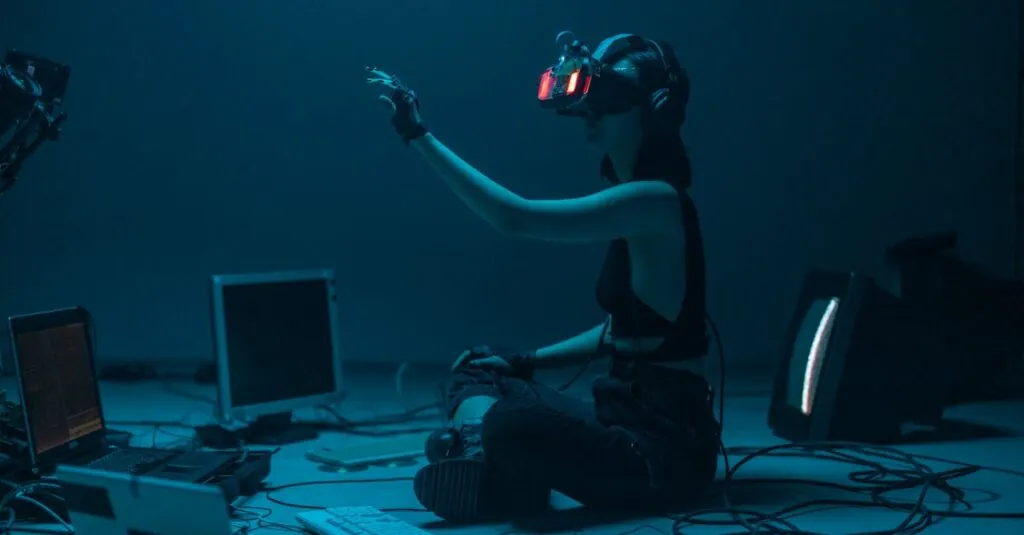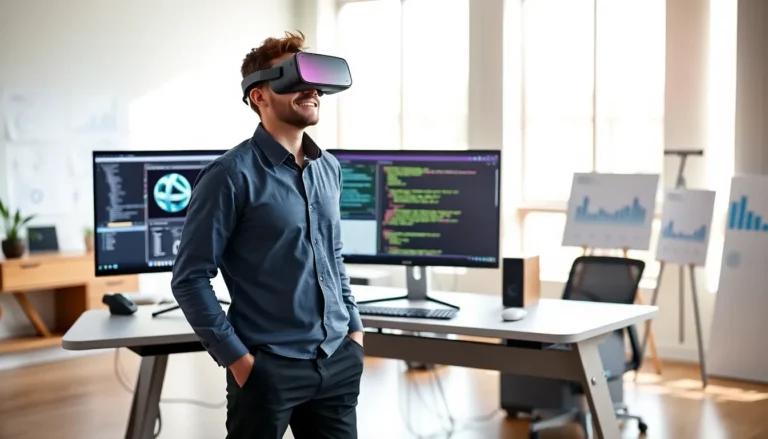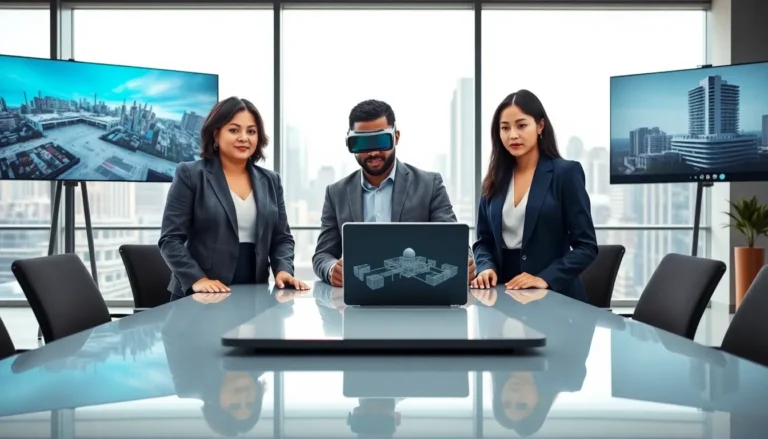Virtual reality is no longer just a sci-fi fantasy; it’s reshaping industries and how we interact with digital content. But before diving into this immersive world, one must navigate the essential building blocks: VR frameworks. Think of them as the unsung heroes behind the curtain, quietly orchestrating the magic that transports users into alternate realities.
Table of Contents
ToggleOverview of VR Frameworks
VR frameworks deliver essential structures for building immersive applications. They facilitate interactions between users and virtual environments. Several prominent frameworks exist, each catering to different needs and platforms.
Unity serves as one of the leading VR frameworks, renowned for its versatility. Developers rely on Unity for creating both 2D and 3D experiences. Another significant framework is Unreal Engine, which excels in producing high-fidelity graphics and realistic physics.
WebXR represents a vital framework designed for web-based VR applications. This standard ensures compatibility across devices using web browsers. A-Frame offers a user-friendly approach for developers working on web VR, simplifying the process of creating interactive experiences.
OpenVR provides an open-source platform that supports various VR hardware options. Its flexibility allows developers to build applications that function seamlessly across different VR headsets. Additionally, Oculus SDK offers specific tools tailored for Oculus devices, enhancing the VR development experience for those targeting the Oculus ecosystem.
Choosing the right framework depends on project requirements, user experience, and desired graphical quality. Accessibility also factors in, especially when developing for diverse platforms. With these frameworks, developers can create rich, engaging content that pushes the boundaries of VR technology.
Key Features of Popular VR Frameworks
Numerous VR frameworks offer unique features that enhance the development process. Exploring these key features helps developers make informed decisions based on their project needs.
Cross-Platform Compatibility
Cross-platform compatibility ensures VR applications reach wider audiences. Unity supports various platforms, such as VR headsets, mobile devices, and PCs. Unreal Engine also enables developers to deploy projects across multiple operating systems, improving accessibility. WebXR facilitates browser-based experiences, allowing seamless interaction on diverse devices. A-Frame’s inherent web-based design simplifies integration with existing web technologies for broader compatibility. Additionally, OpenVR’s open-source approach attracts developers looking to support a range of hardware options effectively.
Development Tools and Support
Development tools and support significantly influence the ease of the VR development process. Unity offers a vast asset store, providing ready-to-use components and plugins, which accelerates project timelines. Unreal Engine features extensive documentation and a plethora of online tutorials, enabling quick learning curves. WebXR’s compatibility with common web standards streamlines the development of web applications. A-Frame encourages collaboration through its active community, offering forums for troubleshooting and feedback. Oculus SDK specifically caters to Oculus device developers, providing optimized performance and tailored resources for an enhanced user experience.
Comparison of Leading VR Frameworks
Several VR frameworks excel in their functionality and features, catering to various development needs and user experiences. Here’s a detailed look at some of the leading options.
Unity3D
Unity3D stands out for its versatility in creating immersive 2D and 3D experiences. Developers appreciate its extensive asset store, which simplifies resource access and speeds up project timelines. Cross-platform compatibility allows creations to reach diverse audiences, enhancing user engagement. Support for a range of VR devices reinforces Unity’s popularity among developers. Continuous updates and a strong community contribute to a wealth of tutorials and resources that assist in overcoming challenges during development.
Unreal Engine
Unreal Engine is renowned for high-fidelity graphics and realistic physics. Developers leverage its powerful rendering capabilities to create visually stunning environments. A robust documentation library provides essential resources for processing complex coding tasks. This framework supports various platforms, ensuring broad accessibility of applications. Developers favor Unreal Engine for its Blueprints visual scripting system, which streamlines the coding process, making it easier for those who prefer a more visual approach.
A-Frame
A-Frame simplifies the development of web-based VR experiences. Built on top of HTML, it allows developers to create immersive content without intricate coding. Accessibility is one of its primary benefits, as users can engage with content directly in their browsers. Community collaboration strengthens A-Frame, providing numerous plugins and components that enhance functionality. This framework targets both beginners and experienced developers, making VR creation more approachable and enjoyable for everyone.
Applications of VR Frameworks
Virtual reality frameworks find extensive applications across diverse fields, enhancing experiences and outcomes. Notable sectors include gaming, education, and healthcare, showcasing the versatility of these technologies.
Gaming
Gaming represents one of the most popular areas for VR framework applications. Developers leverage Unity for its extensive asset store, facilitating rapid content creation. Unreal Engine, with its high-fidelity graphics, delivers immersive experiences that engage players deeply. WebXR enables browser-based games, eliminating installation barriers and attracting broader audiences. A-Frame simplifies the process of creating interactive VR content, making development accessible for newcomers. This fusion of creativity and technology enriches the gaming landscape continually.
Education
VR frameworks revolutionize educational experiences by providing immersive learning environments. Instructors utilize platforms like Unity to create engaging simulations that enhance understanding of complex subjects. Interactive lessons in virtual classrooms allow for safe exploration of historical events and scientific phenomena. A-Frame serves well in creating accessible web-based educational tools, fostering participation in remote learning. Students benefit from personalized experiences that adapt to learning styles and needs, driving retention and enthusiasm for knowledge.
Healthcare
Healthcare applications of VR frameworks demonstrate significant potential for training and patient care. Medical professionals use Unity and Unreal Engine for simulations that mimic real-life procedures, enhancing training realism. VR technologies facilitate therapeutic sessions for patients, aiding in the treatment of phobias and anxiety disorders. OpenVR supports various hardware and environments, allowing clinicians to customize therapeutic experiences effectively. By integrating VR into healthcare practices, professionals can improve patient outcomes and streamline education efficiently.
Future Trends in VR Frameworks
Emerging trends in virtual reality frameworks indicate a shift towards enhanced user engagement and accessibility. Developers increasingly prioritize cross-platform compatibility, allowing applications to function seamlessly on various devices and operating systems. This trend addresses a growing user base that seeks versatility, with frameworks like Unity and Unreal Engine leading the charge.
Integration of artificial intelligence continues to revolutionize VR development. By leveraging AI, frameworks can create more adaptive and personalized experiences, catering to users’ preferences and behaviors. This technology enhances realism in simulations, making environments feel more immersive and interactive.
As the demand for cloud-based VR experiences rises, companies focus on developing frameworks that support online collaboration and multiplayer environments. WebXR plays a significant role in this evolution, enabling browser-based applications that connect users globally without needing substantial hardware investments.
Accessibility remains a key consideration in future VR developments. A-Frame’s community-driven approach fosters innovation, allowing developers to create content with minimal coding skills, thus broadening access to VR experiences. Simplified development tools will encourage participation from diverse creators and industries.
Sustainability also emerges as an important trend within VR framework development. Developers seek to minimize energy consumption and environmental impact while creating engaging virtual experiences. Open-source platforms, such as OpenVR, allow for collaborative improvements, promoting sustainable practices in the VR community.
Lastly, VR frameworks will likely increasingly incorporate mixed reality elements. This integration blurs the lines between the physical and digital worlds, enriching user experiences and expanding application possibilities across various sectors, such as education and healthcare. As technology advances, the adaptation and evolution of VR frameworks will continue to shape the future of immersive experiences.
The landscape of virtual reality frameworks is continually evolving. Each framework brings unique strengths that cater to different development needs and industry applications. As VR technology advances, the emphasis on user experience and accessibility will only grow. Developers are encouraged to explore these frameworks to harness their potential in creating innovative and engaging content. The future of VR is bright with endless possibilities for creativity and collaboration across various sectors. Embracing these frameworks will undoubtedly lead to richer experiences that push the boundaries of what’s possible in virtual environments.










